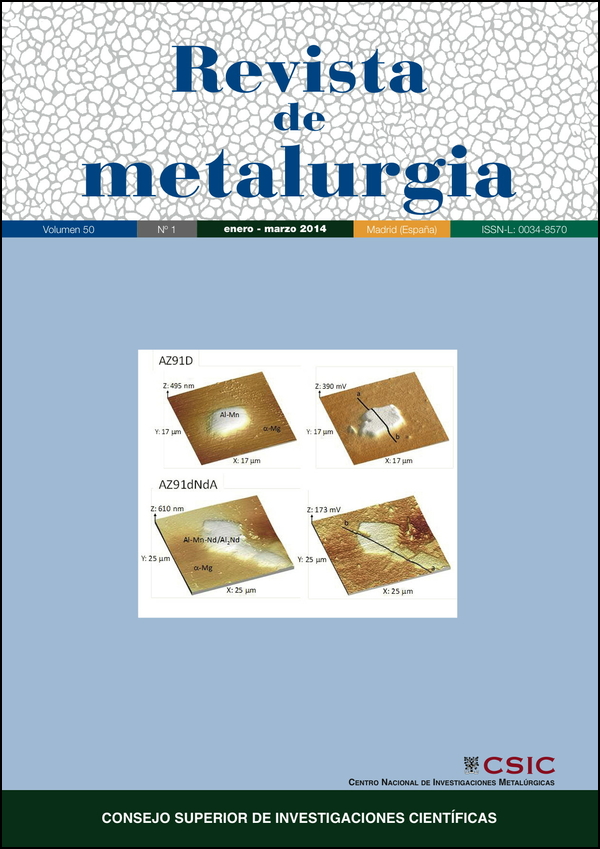Fabrication and characterization of Ag-Cd/CdO materials produced by incorporation of CdO particles to liquid Ag-Cd alloys
DOI:
https://doi.org/10.3989/revmetalm.009Keywords:
Ag-Cd/CdO, CdO, Electrical contactor, Internal oxidation, Kinetic, Reaction frontAbstract
In the present work it has been investigated the kinetic behavior of internal oxidation processes of strips of Ag-Cd/CdO materials fabricated by adding CdO particles (size of 5 and 20 μm) in liquid Ag-Cd alloys. It has been established the metallurgical mechanism that controls the formation of the thickness covered with CdO particles produced by internal oxidation of the Ag-Cd/CdO material. It has been developed, successfully, a metallographic preparation technique for characterizing the morphology, size and distribution of CdO particles produced by heat treatment of internal oxidation on the surface of each sample based on the distance from the original surface to the boundary of dispersed CdO particles. The material strips were sequentially roughed on its surface and the roughing thickness was measured in the cross section of each new surface to determine the number of particles per area and average particle size.
Downloads
References
ASTM E3-95, 1995. Standard Practice for Preparation of Metallographic Specimens, ASTM International, 1–8.
Baez C.J.C. 1999. Procesamiento de materials de Ag-CdO para contactores eléctricos por compocolado y conformado en estado pastoso. CINVESTAV, Saltillo, México.
Behrens, V., Weise, W. 2003. 10 Contact materials. Powder Metallurgy Data, Landolt-Börnstein, Group VIII Advanced Materials and Technologies, Volume 2 A1, 637–666.
Brandes, E.A., Brook, G.B. 1992. Smithells Metals Reference Book. Butterworth Heinemann, Oxford., 7th Edition, 12–19, 13–7, 13–10.
Bohm, G., Kahlweit, M. 1964. On the internal oxidation of metal alloys. Acta Metall. 12 (5), 641–648.
Darken, L.S. 1942. Diffusion in metal accompanied by phase change. Trans. Metall. Soc. AIME, 150, 157–169.
Hashim, J., Looney, L., Hashmi, M.S.J. 2002. Particle distribution in metal matrix composites Part I. J. Mater. Process. Tech. 123 (2), 251–257. http://dx.doi.org/10.1016/S0924-0136(02)00098-5
Joly, P.A., Mehrabian, R. 1976. The rheology of a partially solidified alloy. J. Mater. Sci. 11, 1393–1418. http://dx.doi.org/10.1007/BF00540873
Kofstad P. 1988. High Temperature Corrosion. Springer, 1 Edition, Department of Chemistry, University of Oslo, Norway.
Laurent, V., Jarry, P., Regazzoni, G., Apelian, D. 1992. Processing-microstructure relationships in compocast magnesium/SiC. J. Mater. Sci. 27, 4447–4459. http://dx.doi.org/10.1007/BF00541578
Lloyd, D.J. 1989. The Solidification Microstructure of Particulate Reinforced Aluminium/SiC Composites. Compos. Sci. Technol. 35 (2), 159–179. http://dx.doi.org/10.1016/0266-3538(89)90093-6
Manning, C.R., Gurganas, T.B. 1969. Wetting Binary Aluminum Alloys in Contact with Be, B4C, and Graphite. J. Am. Ceram. Soc. 52, 115–118. http://dx.doi.org/10.1111/j.1151-2916.1969.tb11193.x
Meijering, J.L., Druyvesteyn, M.J. 1947. Metals by Internal Oxidation, Part II. Philips Res. Rep. 2, 260–280.
Naidich, J.V., Zhuravlev, V.S., Chuprina, G.V., Strashinskaya, L.V. 1973. The wettability of solids by liquid metals. Sov. Powder Metall. Met. Ceram. 12, 895.
Parashivamurthy, K.I., Kumar, R.K., Seetharamu, S., Chandrasekharaiah, M.N. 2001. Review on TiC reinforced steel composites. J. Mater. Sci. 36 (18), 4519–4530. http://dx.doi.org/10.1023/A:1017947206490
Rapp, R.A. 1961. The transition from internal to external oxidation and the formation of interruption bands in silver-indium alloys. Acta Metall. 9 (8), 730–741. http://dx.doi.org/10.1016/0001-6160(61)90103-1
Rapp, R.A. 1965. Kinetics, microstructures and mechanism of internal oxidation-its effect and prevention in high temperature alloy oxidation. Corrosion 21 (12), 382–401. http://dx.doi.org/10.5006/0010-9312-21.12.382
Rhines, F.N. 1940. Utilization of Ni66 in Tracer Diffusion Studies. Trans. Am. Inst. Min. Metall. Pet. Eng. 137, 246–286.
Rhines, F.N., Johnson, W.A., Anderson, W.A. 1942. Rates of high temperature oxidation of dilute copper alloys. Trans. Am. Inst. Min. Metall. Pet. Eng. 147, 205–221.
Rohatgi, P.K., Asthana, R., Das, S. 1986. Solidification, structures, and properties of cast metal-ceramic particle composites. Int. Mater. Rev. 31 (1), 115–139. http://dx.doi.org/10.1179/imr.1986.31.1.115
Schmalzried, H., Backhaus-Ricoult, M. 1992. Internal Solid State Reactions. Prog. Solid. State. Ch. 22 (1), 1–57. http://dx.doi.org/10.1016/0079-6786(93)90007-E
Shen, Y.S., Zdanuk, E.J., Krock, R.H. 1971. The Influence of Additives on the Formation of Periodic Precipitation (Liesegang Bands) in the Ag-Cd System. Metall. Trans. 2 (10), 2839–2844. http://dx.doi.org/10.1007/BF02813261
Swisher, J.H. 1971. In Oxidation of Metals and Alloys. American Society for Metals, Metals Park, OH, USA.
Wagner, C. 1959. Types of reaction in the oxidation of alloys. J. Electrochem. Soc. 63, 772–782.
Wagner, C. 1961. Theory of precipitate change by redis-solution (Ostwald ripening). J. Electrochem. Soc. 65, 581–591.
Published
How to Cite
Issue
Section
License
Copyright (c) 2014 Consejo Superior de Investigaciones Científicas (CSIC)

This work is licensed under a Creative Commons Attribution 4.0 International License.
© CSIC. Manuscripts published in both the printed and online versions of this Journal are the property of Consejo Superior de Investigaciones Científicas, and quoting this source is a requirement for any partial or full reproduction.All contents of this electronic edition, except where otherwise noted, are distributed under a “Creative Commons Attribution 4.0 International” (CC BY 4.0) License. You may read here the basic information and the legal text of the license. The indication of the CC BY 4.0 License must be expressly stated in this way when necessary.
Self-archiving in repositories, personal webpages or similar, of any version other than the published by the Editor, is not allowed.
















